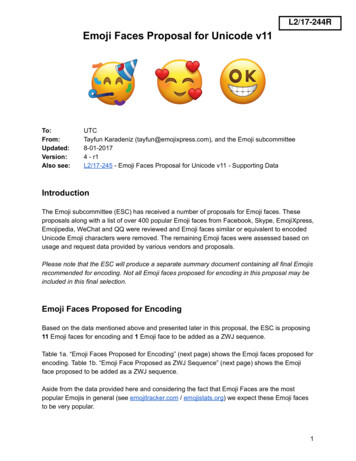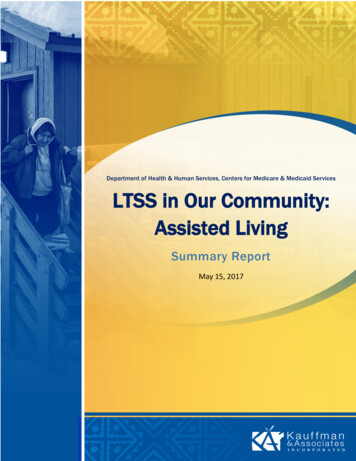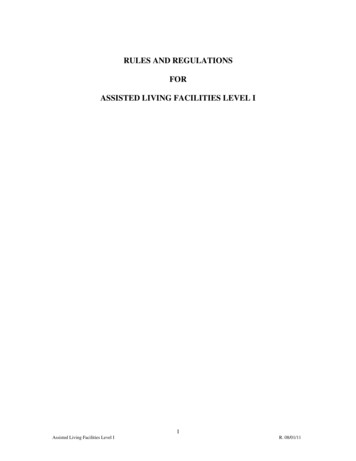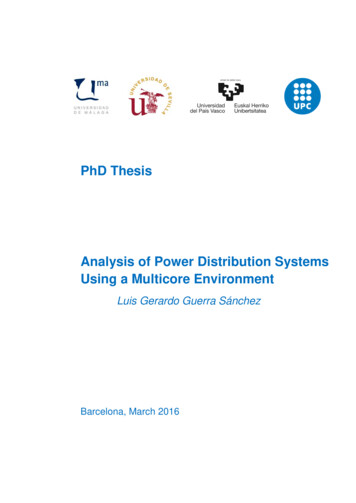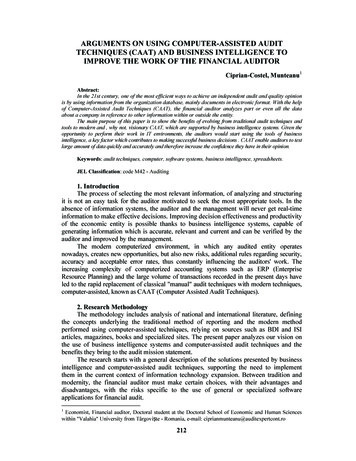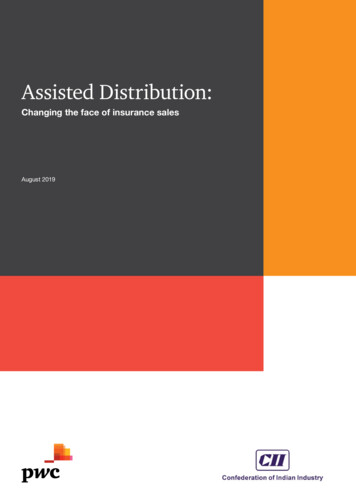
Transcription
Assisted Distribution:Changing the face of insurance salesAugust 2019
Table of contentsForeword. 31. Insurance sector in India. 41.1. A significant opportunity. 41.2. Distribution mix. 42. Insurance distribution at a crossroads. 52.1. Changing behaviour of the Indian customer. 52.2. Technological advancements. 62.2.1. Adoption of InsureTech.62.2.2. New business model and distribution trends.62.2.3. Increased use of technology in reinsurance.72.3. Future of insurance distribution. 73. Dynamics of face-to-face distribution. 83.1. Adoption and customer engagement: The twin challenge. 103.2. Adoption. 103.3. Customer engagement. 114. Addressing adoption and engagement challenges. 134.1. Layered assisted sales platform. 134.2. A structured approach for distribution effectiveness. 155. Enabling a fit-for-future insurance ecosystem. 16
ForewordThe insurance industry has been at the forefront of economic development in India. Gross premiums have grown at acompound annual growth rate (CAGR) of 6.2% over the last decade,1 pushing the Indian insurance industry into the leagueof larger economies globally. During this period, customer behaviour has changed significantly. Nearly 25% of customersavail of digital channels not just to understand but also compare the various insurance products.2 Further, enterprises havebecome more connected and aware through the rapid adoption of the Internet of things (IoT) and other devices.The connected world and the rise of digital technologies mark the dawn of a data-driven era and enable insurers tooften make judicious decisions with financial rewards. Today’s customers are prompted with relevant informationeven before they identify a need and have greater access to information anytime and anywhere. These developmentshave intensified the competition among insurers. In addition to the lack of brand loyalty in the insurance sector,another challenge is that consumers now expect exemplary service to be seamlessly delivered across a range ofcommunication touchpoints.A significant way in which insurers are transforming themselves to adapt to the digital world is by enabling distributionpartners and changing the way the traditional face-to-face sales model works. The evolving insurance sales processnow encompasses a customer-centric approach instead of a product-led approach. Such an approach requiresextensive understanding of customers’ financial needs and their current financial situation, ease of use and the ability toanalyse data in order to identify a solution that caters to the customer’s requirement.Primarily, there are two major shifts in the insurance sales approach meant to enable insurers to be fit for future:1. Shift from product sales to relationship-based selling and subsequently to expertise-based selling.2. Shift from plain script-based selling skills to behavioural skills and subsequently to expert financial advisory skills.This entails having a strong understanding of the market and the ability to interpret a significant amount of market/economic data to provide advice.These shifts have led to a more sophisticated advisory process. Digital solutions are being adopted, given the need tomodel and process huge volumes of data. To be fit for future, distribution partners will need to equip themselves to usetools that enable them to leverage a significant amount of economic, financial, demographic and behavioural data andoffer data-driven advice.Also, customers are changing fast and are demanding more choices at a more rapid pace and lower costs. Levels ofstickiness and brand advocacy have reduced significantly in the financial services industry. So it is imperative for anorganisation to necessarily create value-added propositions. Therefore, insurers will have to focus on the followingvalue-added propositions going forward: Personalised and well-informed interaction: Engagement with the customer will need to be improved qualitativelyand tangibly by demonstrating data-driven simulations on a real-time basis. Customers should be able to seerelevant product fitment in their financial life and should be provided with an option to dynamically modify products. Insightful journey: Insurance awareness has been low in general. The ‘customer of the future’ will want tounderstand products in a very simple fashion. The sales process would have to ensure that customers are guided inthe right direction based on their life stage/profile and data on their insurance habits. Paperless environment: Insurers of the future would have to ensure seamless processes and simple one-stopsolutions to meet most customer needs. They will also have to ensure end-to-end straight-through processing ofpolicies to improve TATs and overall customer experience. Social integration: With the increased adoption of digital and social media, there is significant potential for both leadgeneration as well as continuous engagement. Insurance agents need to integrate their social media presence withadvisor platforms in order to help establish an advisor brand recall in the minds of the customers and thus buildtrust in their client relationships.Given this backdrop, this report elaborates on the distribution challenges faced by the insurance sector. It also identifiesthe key considerations for defining a future operating model as insurers move up the growth curve. The report suggeststhat provision of layered assistance based on the specific needs of distribution partners will help improve their salesefficiency and lead to better adoption. In view of its relevance, this report will generate animated discussions amonginsurance leaders on the layered assisted sales model and the effectiveness of such a solution for insurers, theiremployees and distribution partners.1 PwC analysis2 PwC. (2014).Insurance 2020: The digital prize – Taking customer connection to a new level. Retrieved from ssets/pwc-digital-non-life.pdf3 PwC Assisted Distribution: Changing the face of insurance sales
01Insurance sector in IndiaA significant opportunityThe future of the insurance industry looks promising, with several changes such as tax incentives on insuranceproducts, amendments to make the sector attractive for foreign participants and a move towards open architecture forlarger penetration being made to the regulatory framework. Demographic factors such as an expanding middle class,young insurable population, growing awareness of the need for protection and retirement planning will support thegrowth of the Indian insurance sector.A young and growing insurance population is a blessing for Indian insurers, who can offer a complete suite of insuranceproducts to customers throughout their life cycle, thus creating a large potential market for insurance products. In 2017,India’s life insurance penetration stood at 2.76%, while non-life penetration was at 0.93%. Evidently, the sector has thepotential to grow exponentially in the coming years.3Distribution mixIn terms of premium, more than 99% of life insurance policies are sold through face-to-face distribution4 and for theremaining 1%, premiums are paid through web aggregators or online channels. In terms of number of policies, theshare of face-to-face distribution reduces to 98.75%, and online and web aggregator channels contribute 1.25%.5For the non-life insurance sector, the major contribution is from face-to-face channels such as agents and brokers.Distribution mix for the insurance sectorPremium-wise life insurance mixPremium-wise non-life insurance 0.1%Individual agentsDirect sellingIndividual agentsDirect selling#Corporate agents – banksWeb aggregatorCorporate agents – banksOthersCorporate agents – othersOnlineCorporate agents – othersMI agentOthersBrokersBrokersSource: IRDA Handbook FY18, IRDA Annual Report FY18#Some part of this is through online channels and web aggregators.These figures establish the importance of face-to-face interactions with the customer in the insurance sector. Today’scustomer has access to several digital and technological platforms for purchasing products. This behaviour isbecoming increasingly pronounced and it will have an impact on how customers and sellers interact in the future.3 IRDA Annual Report, 20184 Face-to-face distribution includes individual agents, corporate agents (banks and others), brokers and direct selling.5 IRDA Handbook - 20184 PwC Assisted Distribution: Changing the face of insurance sales
02Insurance distributionat a crossroadsLike any other industry today, the insurance industry is also undergoing significant changes, leading to concernsamong insurers across the globe. According to PwC’s 22nd CEO Survey on potential business threats, 31% of insurerswere extremely concerned about the speed of technological changes, 21% see constantly changing consumerbehaviour as a major challenge, and 10% are losing sleep over new market entrants.6The rise of InsureTech companies, enhanced ecosystem-led distribution models, digital offerings by new age banksand non-banking financial companies (NBFCs), and regulatory changes such as a move towards open architecturehave made this business quite competitive. Further, changing customer behaviour has forced traditional insurers torethink their existing strategies and distribution models and leverage complementary capabilities effectively to build asuccessful ‘distribution model of the future’.Changing behaviour of the Indian customerIrreversible changes in consumer behaviour led by rapid adoption of smartphones (expected to almost double from468 million in 2017 to 859 million by 20227) and the Internet are forcing insurers to innovate and change their operatingmodels. India’s young population (65% of the population is below 30 years) and cheap Internet data (at USD 0.26 pergigabyte, Internet data in India is the cheapest in the world 8) are the reasons behind the huge Internet user base ofaround 357 million in 2017, which is going to increase to almost 840 million by 2022.9Customers are better informed as they have easier access to information. As a result, insurers will need to shift fromproduct centric to customer-centric business models and value propositions. The evolution of e-commerce has changedthe way customers research, compare and make decisions on products and services they want to buy. In the insurancesector specifically, aggregators and other distribution intermediaries have made insurance-related information available atcustomers’ fingertips, allowing them to make informed product choices as per their individual needs.Customer today.wants to make aninformed decision35%growth in searchesfor product reviews.wants to make afaster decision120%growth in searches for‘same-day shipping’.wants to have atailored experience60%growth in searches‘ for me’ searchesSource: Think with Google report (July 2018) /)Continuous and relevant engagement with customers is becoming more important than ever to ensure higher brandadvocacy, leading to retentions, renewals and higher product holdings. Ensuring that high-value channels meet thisevolving customer expectation while being efficient and productive is important for insurers.6 PwC. (2019). 22nd Annual Global CEO Survey Trend Series. Retrieved from df7 PwC. (2018). Video on demand: Entertainment reimagined. Retrieved from ideo-ondemand.pdf8 Roy, Prasanto K. (18 Mar 2019). Mobile data: Why India has the world’s cheapest. BBC. Retrieved from 9 Cisco. (2018). VNI Complete Forecast Highlights. Retrieved from https://www.cisco.com/c/dam/m/en ts/pdf/India Device Growth Traffic Profiles.pdf5 PwC Assisted Distribution: Changing the face of insurance sales
Technological advancementsFor seamless interaction with the customer, more than 80% of CEOs have made artificial intelligence a critical partof their business model or would be doing so in the next three years.10 IoT devices can change the way a customerbuys insurance by sending real-time information related to customer behaviour to the insurer. These technologicaladvancements are changing the way products and services are defined, delivered and used. The adoption of roboticprocess automation, artificial intelligence, analytics, the Internet of things and Blockchain is going to influenceestablished businesses. While this will create significant competitive and operational challenges, it will pave the way forinnovation and improving customer engagement and experience, reduce cost and bring in operational efficiencies.Adoption of InsureTechWith the aim to reduce customer pain points, new startups are coming up with new age solutions. These solutionsnot only provide excellent customer service but also provide faster and cheaper alternatives to traditional insurance.For instance: Use of drones to capture pictures to identify property and problems associated with it Use of automated insurance agen ts (chatbots) to offer insurance policies11InsureTech drives seller collaborationIncreasingly, insurers are dealing with a range of providers (data, distribution partner, claim risk management) in orderto run the business in a more efficient manner. In such scenarios, it becomes imperative to allow an agile integration ofthese partners into an insurer’s platform. Such a platform also fosters stronger tie-ups with sellers who have investedin their own selling platforms resulting into faster exploration, integration and faster speed to market. Insurers areincreasingly looking to develop the following capabilities: Creating more value, by building bridges for the ecosystem Agile integration to bring sellers (fintech partners, aggregators, brokers) and insurer on to a single platform toefficiently bridge the demandsupply gap Enabling open technology platforms to orchestrate partnerships requiring minimal effort from sellers as wellas insurer Continuous monitoring of partnership to ensure profitability. Consistent scanning and scouting of new fintechpartners to provide maximum ROINew business model and distribution trendsWith the advent of new business models like peer-to-peer and digital insurance, insurance companies are nowmore open to strategic alliances and to partnering with various ecosystems of collaborators. Sales and servicing ofcustomers via these channels will be very different from the way the customers are conventionally handled. In fact, thiswould require a complete reimagination of the distribution ecosystem. Peer-to-peer (P2P) insurance is bringing people with the same insurance need(s) together by creating a poolof capital. In case of a loss, money from the pool is used to cover the losses and since everyone in the groupknows one other, the chances of a claim being rejected are lower, thus leading to a safe policy compared to atraditional one. Companies opting for self-insurance do not pay regular premiums to insurance companies and instead pay outclaims for each self-insured employee through a specially set up fund. While this model was restricted to someorganisations earlier, with the emergence of new technologies, self-insurance can become a viable method for awider set of businesses.01P2P insurancePool of premium for sameinsurance need people02Digital insuranceInsurance as added feature03Self-insuranceNo third-party premium,insuring with separate fund10 PwC. (2019). 22nd Annual Global CEO Survey Trend Series. Retrieved from df11 6 PwC Assisted Distribution: Changing the face of insurance sales
Digital insurance is fast enabling insurance on the go by eliminating the need for customers to visit a website or aninsurance seller. For instance, cab-hailing service providers are offering insurance to customers for the duration oftheir journey. New insurance intermediaries Insurance distribution is becoming more broad-based everyday with the entry ofe-commerce players, telcos, InsureTech companies, social engines, etc. Well-established players could benefitheavily from these firms by leveraging their ability to provide a seamless customer experience using new serviceconcepts like robo-advisors. The incorporation of FinTech solutions may additionally result in a better clientexperience as well as an increase in integrated customer engagement touchpoints. Currently, FinTech is mainlyrestricted to buying, billing and claim processing.Increased use of technology in reinsuranceOne of the important aspects of commercial insurance sales is interaction with the reinsurance entity. The complexsales process requires trust and transparency between multiple involved parties (customer, broker, insurer andreinsurer). Blockchain may be an effective solution in this space because of the way the technology works. It isdistributed, immutable and helps mitigate risk associated with single ownership. It can enable seamless exchangeof information, acceptance of terms and conditions, pricing structures and risk management processes. Use of suchtechnology in commercial insurance distribution has the following advantages: Reduced disputes due to time stamped audit trail Reduced duplication, manual flow and regulatory reporting Safer for policy holders, as they can show immutable record of their being insured No single point of failure/processing bottleneck in a process12Future of insurance distributionIn light of the changing customer preferences, regulations and technological advancements, new business anddistribution models have to be imagined. Some new age insurers are attempting to provide a seamless and superiorcustomer buying and servicing experience using digital platforms and revamped ecosystems. These ecosystemchanges are pushing traditional insurers to augment the capabilities of the current face–to-face distribution model. Webelieve that the future of insurance distribution in India will centre around three prominent models:1. Self-directed distribution: The growth of a tech-savvy customer base is resulting in a focus on the ready availabilityof advice/transaction capabilities through multiple channels, especially the online channel. This distributionapproach relies on engaging the user, ensuring comfort, providing convenience and encouraging independentdecision making and self-service. The approach leverages data from diverse sources in real time to offer apersonalised experience.2. Assisted distribution: Face-to-face distribution models will increasingly move towards tech-assisted models wheretechnology will be significantly integrated with the provision of advice. The approach will ensure empowermentand enablement of sellers. It also relies on the adoption of such platforms and extension of support to drive betterengagement during seller-customer interactions.3. Affinity-based distribution: Sustained low penetration levels in insurance will lead insurers to further review ofpartnerships in order to provide services beyond the sale of insurance products, leading to fulfilment of customergoals (e.g. fitness-linked health insurance premium). These partnerships will need to be carefully evaluated foraffinities so that they see significant adoption and scale.The above models will work in tandem and can be used by insurers depending on the geography or segment they aretargeting. However, since insurance and banking products are quite complex, even simple services require manualassistance. A study by PwC suggests that 55% of people prefer to buy policies from a broker/agent which is theprimary channel for face to face distribution.13Hence, we believe that insurers will need to focus on an assisted distribution approach over the next 3–5 years in orderto make an impact on existing customers and acquire new customers. Assisted distribution should not be confusedwith mere ‘mobile and tablet enablement’ of sellers, which has been in place for quite some time and has been aneffective tool in building familiarisation with digital tools. Insurers will have to work simultaneously on people, processand technology to make this approach effective, and will have to ensure that this approach results in a customeroriented solution such that it is able to cater all the needs of the customer.12 pdf13 PwC. (2019). Competing in a new age of insurance: How India is adopting emerging technologies. Retrieved from: 7 PwC Assisted Distribution: Changing the face of insurance sales
Dynamics offace-to-face distribution03Face-to-face channels of sales would continue to dominate due to customer preferences for buying insurance, despitea significant change in other products. It’s important for insurers to examine some of the foundational and corechallenges and identify efficient solutions for them.Attractiveness of insuranceas a career optionActivation and retentionProductivityHow to re-invigorate theentrepreneurial spirit toattract talent to careers ininsurance salesLoss of interest in insurancesales as a career due to fallingincomes or availability ofother optionsHow to keep the funnel ofprospects moving and enhanceproductivity per customerAttractiveness of insurance as a career optionIn an age of start-ups and with self-employment having become a buzzword, especially amongst the millennials/GenY, commission-led agencies or a salary-based face-to-face insurance sales model has low appeal as a career option.Although multiple opportunities are available to insurance agents in terms of job security, income viability, growthand learning, there has been no major increase in the motivation of job aspirants. In fact, the number of independentinsurance agents has dropped from 21.22 lakhs in FY13 to 20.83 lakhs in FY 18.14Insurers have taken steps to market the profession well and enable enrolment even with low academic qualifications(typically high school), more needs to be done in terms of projecting insurance sales as a viable and attractive careeroption and thus attract prospective agents from varied segments, especially Gen X and Gen Y.Activation and retentionDue to the long-term nature and possible complexity of the features of insurance products, sellers perceive them tobe more complex than other financial products. In addition, there could be a mismatch between the product featuresand the agent’s ability to provide a viable solution to customers. This could have a direct impact on the earnings andthereby result in a loss of interest in the profession. Even with a more financially literate group of sellers – for example,a banker – matching the right product to the right need at the right time could become very complex, owing to the largeproduct portfolio available with different margins.ProductivityIndividual agents form a major part of insurance sellers in India. However, their productivity has been a huge concernfor the insurance sector. Productivity of agents in India remains less than their Asian counterpart (As shown in thegraph, % of MDRT* members as total agency population of India is very low compared to their Asian counterparts15)mainly due to lack of information, poor time management and insurance sales being regarded as a secondary sourceof income. This hampers agents’ ability to reach out to more customers, leading to frustration and low sales andproductivity. This low productivity is often reflected in higher time spent per meeting, low sales conversion rates andsmaller ticket size.14 IRDA Annual Reports, 2013 and 2018* For becoming MDRT member you have to be among the top insurance sellers (in terms of premium) in the country15 AAN Team. (5 Sep 2018). Diving into agency force numbers and quality in Asia. Retrieved from n-Asia8 PwC Assisted Distribution: Changing the face of insurance sales
Sales through the banking channel have reaped good results in recent times. However, leveraging of bank partnershipsvaries significantly across the insurance industry, perhaps due to: Difference in sales and prospecting approaches for banking products vs insurance products Level of understanding about third-party (insurance) products among banking staff and the ability to handlecustomer queries about complex products Inherent conflict with bank products like fixed deposits, saving schemes and investment products Lack of governance and a disciplined approach towards the growth of the insurance business Lack of process integration with insurers resulting in processing delays Limited use of analytics and technology to identify potential insurance needs and best-fit solutionsMDRT membership as a percentage of the agency populationSource: Asia Advisers Network report16Risks in the insurance businessDue to increased customer awareness, regulation and evolving technologies, insurers are facing new challenges. Thishas made the insurance industry revise its risk strategies. We can define these risks briefly as follows: Cyber security: The biggest risk that companies face today is theft of consumer personal data or financialinformation of the company. Technology failure may lead to loss of intellectual property rights and reputational andfinancial damages for the company. Change management: Managing customer expectations and keeping the pace with evolving business models andtechnologies are difficult for a company. Competition: Entry of new global players, InsureTechs and adoption of digital platform by various companies willpresent intense competition for the traditional players. These are offering low-cost products with good services tothe customers, which may result in loss of customers for traditional insurers.Insurers will have to think innovatively to mitigate these risks. For instance, Blockchain has considerable applicationin this industry. It can be used to detect fraudulent behaviour and to monitor the claims history and confirm customerauthenticity. Further, AI could be used to enhance customer experience by automating the claim-handling process.It can also empower key processes such as asset management and risk calculation and prevention.1716 AAN Team. (5 Sep 2018). Diving into agency force numbers and quality in Asia. Retrieved from n-Asia17 s-insurance-insightsjune-2018.pdf9 PwC Assisted Distribution: Changing the face of insurance sales
Adoption and customer engagement: The twin challengeInsurance companies have been providing their sellers with technology-based solutions since 2004 and this model hasbeen since replicated by most of the insurers. Often, these platforms are launched with a lot of fanfare, but the adoptionof the platform is primarily to initiate the insurance policy – which is made a mandatory requirement by the insurer forcommission calculation. Further, such platforms have typically not been able to support seller-customer Engagementand improve conversion dAdoptionIt is important to analyse the reasons for low adoption: Is it on the account of sellers’ disinterest in using technology or poor experience (counter-intuitive, complex, and toorigid) even if they would like to use it? Is the platform perceived as additional data entry work which was being done by someone else and which is nowresulting in an additional overhead for the seller? Are customers not keen to review the product illustrations and company documents because of high trust and beliefin sellers’ advice? Does the platform have defects which disrupt the sellers’ work (e.g. connectivity issues, data sync-up issues)? Are there freq
Premium-wise life insurance mix Premium-wise non-life insurance mix 6% 6% 22% 30% 28% 8% 0% Individual agents Corporate agents - banks Corporate agents - others Brokers . becoming increasingly pronounced and it will have an impact on how customers and sellers interact in the future. Distribution mix for the insurance sector

